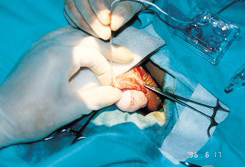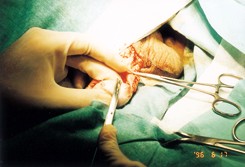Knowledge Sharing
2018.07.13
TESA & MESA
If the cause of male infertility is obstructive azoospermia, non-obstructive azoospermia, sequelae caused by mumps, cryptorchidism, or chromosomal abnormalities, etc., you can consider using the microsurgery of the Testicular Sperm Extraction (TESA) method to obtain a small amount of sperms or immature sperms (Figures 1-26), e.g. spermatids (spermatid), cultivate them in the laboratory till mature sperm period, and then apply the single sperm microinjection method plus IVF treatment. You still have the opportunity to conceive. Don't give up the right of fertility.
In addition, for patients with obstructive azoospermia, because the testicles of these patients can produce sperm worms, they can use Microsurgical Epididymal Sperm Aspiration (MESA) (Figures 1-27) or the technique of Precutaneous of Epididymal Sperm Aspiration (PESA) combined with a single sperm microinjection method. So many cases get pregnant by using this way. Because the sperms obtained from the epididymis are more mature than the sperms obtained from the testicles, the number of sperms are higher and have better activity. After frozen storage, the survival rate after thawing is also quite good. It can save the gentleman from repeating the pain of microsurgery, which is a good news for male with infertility.
⋙ Microsurgical Epididymal Sperm Aspiration is suitable for:
1. Cases of congenital defect of vas deferens or absence of the vas deferens.
2. Epididymal obstruction.
3. Epididymal lesions.
4. A man fails to reconnect vas deferens after ligation operation.
⋙ Electro-ejaculation or Vasal Sperm Aspiration is suitable for patients with retrograde ejaculation, patients who cannot ejaculate, or patients with blocked ejaculation tubules. If the number of sperms is extremely scarce, the method can still be used. The single sperm microinjection method also has a fairly high success rate.
⋙ The advantages of gun-biopsy is that patients can be free from anesthesia, which can reduce the risk of surgery. Can be free from hospitalization, which can reduce the waste of medical costs, can repeatedly obtain testicular sperm and have a higher pregnancy rate.
The indications for gun-biopsy are as follows:
1. Congenital absence of the vas deferens.
2. Obstructive azoospermia.
3. A men receiving a ligation operation.
4. No epididymis.
 Testicular sperm Extraction (TESA) |
 Microsurgical Epididymal Sperm Aspiration (MESA) |
In addition, for patients with obstructive azoospermia, because the testicles of these patients can produce sperm worms, they can use Microsurgical Epididymal Sperm Aspiration (MESA) (Figures 1-27) or the technique of Precutaneous of Epididymal Sperm Aspiration (PESA) combined with a single sperm microinjection method. So many cases get pregnant by using this way. Because the sperms obtained from the epididymis are more mature than the sperms obtained from the testicles, the number of sperms are higher and have better activity. After frozen storage, the survival rate after thawing is also quite good. It can save the gentleman from repeating the pain of microsurgery, which is a good news for male with infertility.
⋙ Microsurgical Epididymal Sperm Aspiration is suitable for:
1. Cases of congenital defect of vas deferens or absence of the vas deferens.
2. Epididymal obstruction.
3. Epididymal lesions.
4. A man fails to reconnect vas deferens after ligation operation.
⋙ Electro-ejaculation or Vasal Sperm Aspiration is suitable for patients with retrograde ejaculation, patients who cannot ejaculate, or patients with blocked ejaculation tubules. If the number of sperms is extremely scarce, the method can still be used. The single sperm microinjection method also has a fairly high success rate.
⋙ The advantages of gun-biopsy is that patients can be free from anesthesia, which can reduce the risk of surgery. Can be free from hospitalization, which can reduce the waste of medical costs, can repeatedly obtain testicular sperm and have a higher pregnancy rate.
The indications for gun-biopsy are as follows:
1. Congenital absence of the vas deferens.
2. Obstructive azoospermia.
3. A men receiving a ligation operation.
4. No epididymis.




